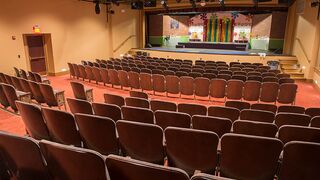Basics Of ADA And Accessibility For Auditoriums
By Anne Chapman
November 5, 2020

Making accessible and ADA-compliant event spaces is a serious responsibility for designers. It allows for everyone who attends events in your facility to have an equally enjoyable experience. Designers will be dealing with a combination of local and federal rules, as well as the unique demands of each space. Getting a strong understanding of what is required can lead to a better viewing experience for everyone.
How Many Wheelchair Spaces Are Needed?
The number of wheelchair spaces needed will depend on the capacity of the venue. The larger the facility, the more spaces that are necessary to satisfy accessibility requirements. While some local requirements may vary, in general, wheelchair spaces must be provided as below:
- four to 25 seats require one wheelchair space.
- 26 to 50 requires two spaces.
- a venue with 51 to 150 seats must have four spaces.
- 151 to 300 requires five spaces.
- 301 to 500 requires six spaces.
Auditoriums with 501 to 5,000 seats must have six spaces, plus an additional one for every 150 (or fraction of 150) seats over 501. So, an auditorium that seats 3,200 people would be required to have 24 wheelchair spaces.
Where Can Wheelchair Spaces Be Placed?
To ensure that every patron has the same opportunity to see the show, wheelchair spaces must be dispersed throughout the venue. They need to have the same variation in sight lines available to other patrons, as well as access to the same choice of admission prices. These spaces also need to adjoin to an accessible route for emergency exits.
It's preferred for wheelchair accessible spaces to be provided in pairs. Every wheelchair space must have a companion seat adjacent to it. The companion seats may be either fixed or removable, to allow for maximum flexibility. The companion seats must also be at the same floor or elevation as the wheelchair seats to allow for shoulder to shoulder alignment. This requires a deeper row spacing and will depend on the design and construction of your seating area.
It's also important to consult local requirements. While it is generally required that wheelchair spaces not be clustered at the front or rear, there may be local waivers for the requirement in some instances. This includes venues where wide dispersal of wheelchair accessible seats is not feasible.
Other Accessibility Concerns
Wheelchair accessibility is not the only concern to keep in mind when designing a space. At least five percent of aisle seats in any space must have retractable or folding armrests. It's worth noting that the percentage addresses only aisle seats and not the total number of seats in the venue.
These seats make it easier for people who have difficulty walking to get in and out. The designated aisle seats must be the ones closest located to accessible routes in and out of the auditorium. They must be marked with approved insignia to make them easier to find.
Features That Make Accessibility More Possible
Designers who are worried about being able to provide enough wheelchair accessible spaces that fit ADA requirements may have more options than they realize. For instance, our ADA/Video Platforms provide flexibility, allowing designers to create modular spaces that can be added or removed as needed. These platforms are supplied in four foot by four foot sections to provide larger viewing areas. They can be used as wheelchair platforms that are accessible from the concourse area, and can be paired with tread-mounted companion seating.
Additionally, removable chairs can be placed in wheelchair spaces to be used when the wheelchair space is not needed. This means that no seat needs to be left empty on the night of a full house.
Irwin’s experience with accessible seating configurations can be seen in venues nationwide, from new installations to upgrading of historic spaces like the Havre de Grace Cultural Center in Maryland. In this space, we were able to help preserve the historic look and feel of the building while also providing a space that is accessible to all.
If you are struggling with accessible design, we can help you find an optimal solution. We're looking forward to helping you meet your duties to your audience while providing a safe and enjoyable space for all.